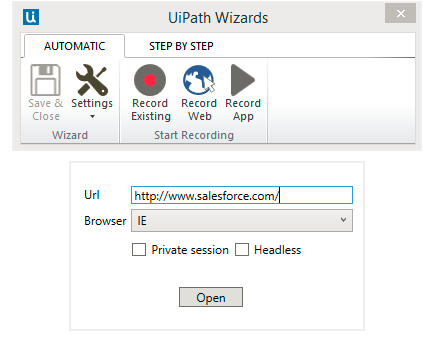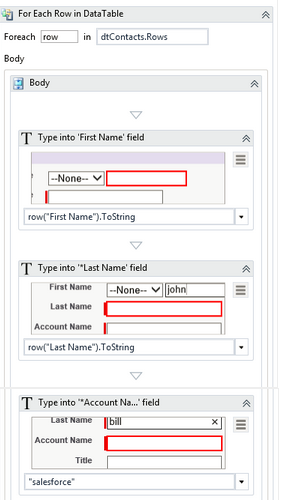UiPath Web Automation: See Exactly How RPA Magic Works
Blog: UIPath.com
Conversations about software robotics tend to fall into one of two categories: the past or the future. For the present, robotic process automation RPA) is the technology with the magic to change the way business does its work. By the end of this article you’ll see exactly how UiPath makes that magic work with Web Automation.
When the conversation is about futuristic robotics, the subject is often DeepMind Technologies, a company recently acquired by Google and focused on reinforcement learning – software’s ability to not only perform a task, but to self-modify based on feedback from its environment. DeepMind is doing remarkable things.
When the conversation is about the past, people tend to either lament or marvel at the occupations and activities that have changed drastically or disappeared entirely. Bank tellers and travel agents? Largely gone.
Unlike these future and past examples, people impacted by RPA actively participate with the technology to change their

work roles and daily activities. This active participation is required because current robotic software has to be told what to do and when to do it. Simply put – software robots need instructions and the best source is the person already doing the task.
The good news is people who actually understand process steps and activities are central to the deployment of workflow automation software. The bad news is.…software robotics can’t work unless the people who understand what needs to be done can configure them. The challenging news is people with valuable process expertise rarely know technology on any type of programming level.
What’s to be done?
RPA providers have responded to this challenge by building two foundational capabiities into their products:
-
An ability to be configured with non-programatic instructions from business users.
-
Functionality to record and mimic human actions, decision rules and exceptions.
The point of these capabilities is the same: to remove technical requirements from the business “instructor” without compromising the effectiveness of the technology. But, does it work? Can business users really configure robotic software to take over appropriate tasks and reap the benefits?
That’s the big question.
And it’s a question that can’t be answered with hype and generalities. To be believeable, to build a “Yes, let’s do it!” level of confidence and determination, business decision-makers must see the question answered with specifics.
So let’s dive in and see – with a specific example – exactly how UiPath works its RPA magic.
Challenge Accelerate onboarding of new sales agents.
Strategy Leverage some form of Salesforce automation software to save time and money
Approach The manager of the business unit responsible for sales agent onboarding met with his first level supervisors to identify any repetitive, rule-driven, activities that could qualify for optimization. Almost a dozen such activities were highlighted.
Decision Importing csv files into the company’s Salesforce system was selected for the first use of robotic software. The activity has few steps, is highly repetitive and rules-driven, and risks from a failed deployment were considered low.
Implementation The manager selected the most experienced business user to gain familiarity with the UiPath product, create a csv importation process template, then share the template and knowledge with the other users.
Process to be Automated:
The user explained that there were eight steps for placing a new agent’s csv contacts into Salesforce.
-
Locate & open the agent’s csv file.
-
Open the Salesforce website.
-
Log into the website.
-
Click “Contacts”.
-
Click “New”.
-
Input the agent’s contact data from the csv file.
-
Click “Save”.
-
Click “New”.
-
Repeat.
Creating the Process Automation Template:
-
The user accessed the agent’s csv file by placing the file name and directory location into UiPath’s standard “Read CSV”/”Read Cell Range” activity.
-
He then opened a Record Web sequence and took the following steps.
-
Type in the Url field: http://www.salesforce.com/

-
Click “Log In” button.
-
Type Username and Password.
-
Click “Log in to Salesforce” button.
-
Click “Contacts”.
-
Click “New”.
-
Click “Save & New”
-
Press Esc to close the Record Web activity.

-
Then the user pressed Esc to close the Record Web activity.
-
Next, the user created a “For Each Row” activity to fit into the process flow – between the “Click “New” and Click “Save & New” – with these three steps.
-
Click “New”.
-
Type into “First Name” field.
-
Type Into “Last Name” field.
-
Type into “Account name” field.
-
-
Click “Save & New”
Outcome:
UiPath’s product enabled the company to create a automated workflow consisting of four activities: locating and reading the sales agent’s csv file; logging into the agent’s Salesforce account and opening up new accounts; using a “For Each Row” activity to populate each name into the new account fields; saving & opening new account fields for the next row of csv data.
More importantly, the company used the knowledge of one user – their most experienced on-boarding person – to create a template for use by everyone in the department, scaling both effort and expertise.
Benefits:
Everything promised by RPA: ease of implementation, elimination of repetitive tasks, savings of time & money, scalability of effort, and user knowledge.
Leave a Comment
You must be logged in to post a comment.








